Bolingbroke Hospital
Wakehurst Road, Wandsworth Common, SW11 6HN
Medical dates:
Medical character:
1880 - 2008
General. Later, geriatric.
The Vicar of St Mary's Church, Battersea - Canon John Erskine Clarke - was the main instigator for the establishment of a voluntary hospital in the area. In 1876 Bolingbroke House, an old red brick 3-storey mansion in Five Houses Lane (now Bolingbroke Grove) overlooking Wandsworth Common, was purchased for £4,500 for this purpose.
A Provident Dispensary, with a resident doctor, was
established in the house for out-patients only until enough money could
be raised to open the wards (the house was large enough to accommodate
50 in-patients).
The Bolingbroke Self-Supporting Hospital and House in Sickness opened
in 1880 and became a small general hospital with 30 beds and an
Accident and Emergency Department. It was one of the first to
cater for both the artisan and middle classes. (While the rich could
afford private treatment in their own homes and the poor received
medical care in workhouse infirmaries, the middle classes could not
afford private nursing care but did not want to be admitted to
infirmaries. By the late 19th century hospitals for those who could
afford to pay a moderate fee began to be established). As with other voluntary hospitals, patients with infectious or contagious diseases, the mentally ill, the incurable, epileptics and maternity cases were not eligible for admission.
In 1893 a ward specifically for accident cases was opened, with casualties received free treatment.
At the end of the century plans were drawn up for the complete rebuilding of the Hospital, including demolition of Bolingbroke House.
The first phase was completed in 1901, when the Hospital was extended by a single-storey wing in Wakehurst Road, at the northeastern part of the site. The new building housed the Out-Patients Department and was named the Victoria Memorial Wing after Queen Victoria, who had recently died.
The second phase began in 1906, when Princess Louise laid a foundation stone for another wing to be added to the north of Bolingbroke House. It was named the Canon Erskine Clarke Wing and contained wards, an operating theatre and a mortuary. The 3 storey building also had a basement. Its flat roof was used as an airing ground for patients and staff.
Another 3-storey ward block - the Bolingbroke Wing - was added just before the outbreak of WW1 in 1914. During the war 20 beds were reserved for military cases transferred from the Third London Hospital. By 1917 this number had been increased to 25 beds. A pre-fabricated X-ray room was built (this was later converted into a chapel).
In 1925 the foundation stone was laid for a new wing by Princess Mary, Viscountess Lascelles. It opened in 1927 and was named the William Shepherd Memorial Wing after William Shepherd, a "philanthropically minded builder". An imposing stair-tower divided the wing into two parts. The ground floor of the southern part contained an 18-bed ward. On the first and second floors were single rooms for private patients and a 4-bedded ward. A corridor connected the building to the Canon Erskine Clarke Wing.
The Hospital then had 120 beds, including 20 cots in a children's ward on the first floor of the Shepherd Wing. The Anne Carmichael Children's Ward was decorated with picture tiles of nursery rhymes and animals.
In 1928 the weekly charge for a private room was 6 guineas (£6.30) or 4 gns (£4.20) for a bed in a 5-bedded ward. This fee included provision of care by the Resident Medical Officer and nurses, board and lodging, medicine, certain stimulants, surgical dressings and the use of the operating theatre. The cost of a special nurse, laundry, massage, pathology and X-ray examination was extra. The attending clinician was paid separately.
In 1928 the average weekly cost of an in-patient was £2 13s 2d (£2.66), compared to £3 13s 6d (£3.67) in 1927. The average length of stay was 17 days.
Following the addition of the new wings, Bolingbroke House itself was hemmed in on three sides, with its front facing the back of the Shepherd Wing. In 1937 the old mansion was demolished and work began to build a central administration block to unify the frontage on Wakehurst Road and to create a main entrance for the Hospital. The Battersea War Memorial Committee provided a scheme by which the new entrance would include a War Memorial for the fallen of Battersea during WW1.
The lobby of the new entrance was lined with marble and comprised a vestibule with a reception booth and an octagonal hall. The hall was made into a Hall of Remembrance. Along the three corridors which ran from the hall were various offices and the Board Room. On the first floor were 6-bedded wards, while the second floor contained accommodation for nursing staff. The top floor contained the main kitchen.
New storerooms and a new mortuary were built in the late 1930s.
In 1938 the average weekly cost of an in-patient was £3 8s 2d (£3.41).
At the outbreak of WW2, it joined the Emergency Medical Service and was affiliated with St Thomas's Hospital. It received bomb damage in 1941 and was hit by a V1 flying bomb in 1944.
In 1946, of its 135 beds, only 118 were open due to a lack of nursing accommodation and the deep cleaning of wards. The average length of stay was 22 days and the average weekly cost of an in-patient was £7 6s 7d (£7.33), compared to £6 9s 7d (£6.48) in 1945. In the same year an X-ray apparatus was installed for radiation treatment of certain skin disorders.
Despite misgivings from the Hospital Board, the Hospital joined the NHS in 1948
with 135 beds under the control of the Battersea and Putney Group Hospital Management
Committee, part of the South West Metropolitan Regional Hospital Board.
For Coronation Day in 1953 Mr KM Hubbard, a local radio and electrical
engineer, loaned 20 TV sets to the Hospital so that the patients could
watch the ceremony. By this time
work had begun on a new wing. Between 1953-1954 the cost per
in-patient was £16 4s 4d (£16.22) per week.
In February 1957 a new X-ray Department was officially opened by Sir Zachary Cope, a former surgeon to the Hospital. It was situated in a new £35,000 single-storey block, perpendicular to the main building, which had been built so that additional floors could be added in the future to create a new wing.
In the same year installation of overhead lights for each bed was completed in the last two wards, so that patients could control their own lighting.
Part of the old X-ray Department was converted into a chapel at a cost of £2,000. When it was completed, a dedication service was held on 21st September 1957 by the Bishop of Kingston, the Rt. Revd. W.P. Gilpin.
In 1959 the Hospital had 129 beds.
A new Coronary Care Unit opened in 1967 and was enlarged in 1972 with more convalescent coronary care beds.
In 1974, following a major reorganisation of the NHS, the Hospital came under the control of the Merton, Sutton and Wandsworth Area Health Authority, part of the South West Thames Regional Health Authority.
In 1974 the Accident and Emergency Department was closed, despite
protests from the local population, and the option was mooted of
completely closing the Hospital because of low bed occupancy.
During the 1980s the Hospital began to focus on services for older
people. By 1989 it had five wards for acute admissions, treatment
and rehabilitation, six beds for respite care and a Day Hospital.
The issue of fire safety was raised, as the elderly patients were
housed on the upper floors and the buildings were deteriorating, but no
remedial action was taken at that time.
In 1993, following the introduction of the 'marketplace'
system in the NHS, the Hospital became part of the newly formed St
George's Healthcare NHS Trust.
In 2004 the Trust reviewed the question of fire
safety and sought the advice of the London Fire Brigade. An
independent fire safety report was then obtained and, on the basis of
that, in 2005, the Trust decided to close the remaining 54 beds, with
in-patients being transferred to nearby nursing homes or community
hospitals, despite more than £2.5m having been spent on
refurbishing the wards the previous year.
The Bolingbroke became a community hospital, with Out-Patient clinics
and various health care services, and a Day Hospital for 15 elderly
patients, but St. George's Healthcare NHS Trust, which owned the site,
and Wandsworth Primary Care Trust, which funded the services located
there, jointly agreed that the Hospital was run-down and underused,
being 80% empty. It was proposed that the facilities would move
to the new St John's Therapy Centre, less than a mile away in St John's Hill.
There was immense opposition from the local community to the closure
and Wandsworth Councillors managed to block the plan. The issue
was referred to the then Secretary of State for Health, Alan Johnson,
who agreed in July 2007 to the closure of Bolingbroke Hospital and the
transfer of clinical services to St John's.
|
Present status (January 2008) Update: August 2012 In 2009 the buildings were Grade II listed. In 2011 Wandsworth Council acquired the site from St George's Hospital Trust. It was planned to use the buildings as the Bolingbroke Academy, a secondary school which is due to open in September 2012. Update: February 2016 The Bolingbroke Academy did indeed open in September 2012. The children's ward with its picturesque tiles is the school's library. The Hall of Remembrance is still used on Remembrance Day. |
|---|
N.B. Photographs obtained in January 2008
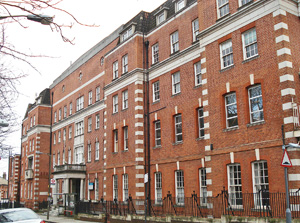
The unified frontage along Wakehurst Road. The buildings were constructed in phases.
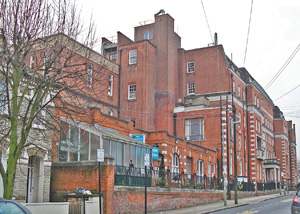
The single-storey Out-Patients Department (shown here with blue signage) - the Victoria Memorial Wing, built in 1901- is the oldest surviving part of the Hospital.
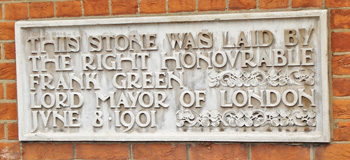
The foundation plaque on the Victoria Memorial Wing.

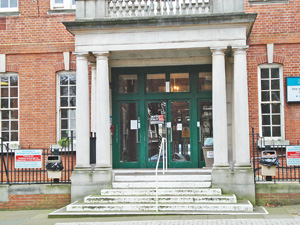
The main entrance is the newest part of the Hospital, built in 1936. The legend 'The Bolingbroke Hospital' is incised in the cornice above the third floor windows. Above the portico further lettering commorates the founding of the Hospital by Canon Erskine Clarke.
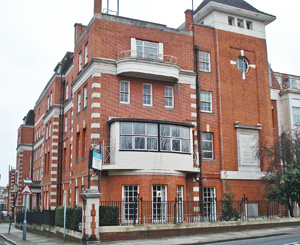
The west corner, looking down Wakehurst Road on the left. Bolingbroke Grove.
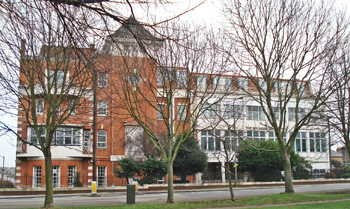
The Shepherd Wing, built in 1927 on the west side of the site along Bolingbroke Grove, as seen from Wandsworth Common. The concrete balconies of the 3-storey ward block have been glazed in.
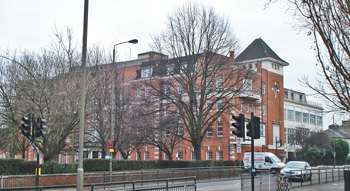
The northwest corner of the Hospital on the corner of Wakehurst Road and Bolingbroke Grove.
N.B. Photographs obtained in April 2012
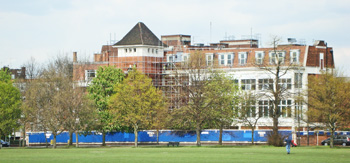
The Hospital buildings seen from Wandsworth Common.
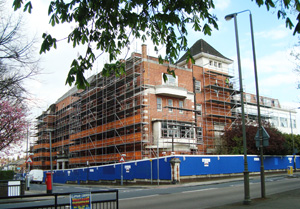
Construction work begins.
N.B. Photographs obtained in June 2012

The buildings are being converted into a school.
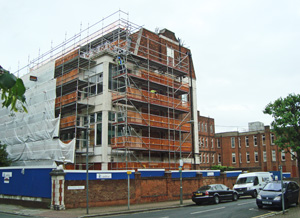
The rear of the site (above and below), as seen from Bellville Road.
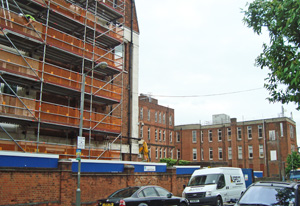
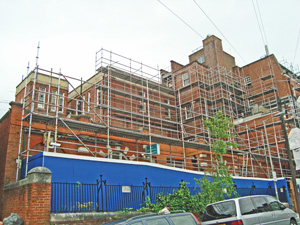
The Victoria Memorial Wing.
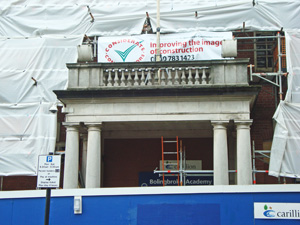
The main entrance.
N.B. Photographs obtained in June 2014
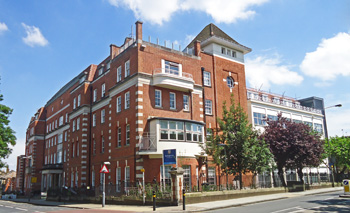
The Bolingbroke Academy (above and below).
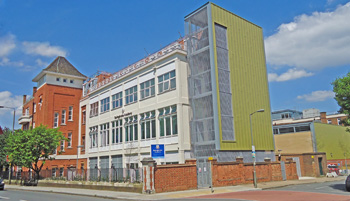

The foundation stone to the Shepherd Wing.
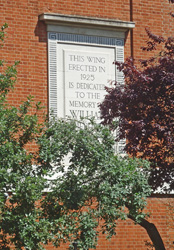
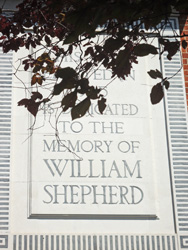
A stone plaque on the front of the Shepherd Wing commemorates William Shepherd.
|
The Hospital is named after the politician Henry St John, Viscount Bolingbroke (1678-1751), who lived in Battersea. The original Hospital building was purchased from his heirs. |
References (Accessed 14th February 2016)
(Author unstated) 1879 The Battersea Provident and Self-Supporting Hospital. British Medical Journal 2 (985), 780.
(Author unstated) 1882 Pay-hospitals. British Medical Journal 1 (1105), 312.
(Author unstated) 1897 Reflections from a Board Room Mirror. Nursing Record and Hospital World 22nd May, 420.
(Author unstated) 1917 List of the various hospitals treating military cases in the United Kingdom. London, H.M.S.O.
Smith M, Sakula A 1994 Hospital Names. London, RSM Press.
http://archive.historicengland.org.uk
http://edithsstreets.blogspot.co.uk
https://historicengland.org.uk
www.britishlistedbuildings.co.uk (1)
www.britishlistedbuildings.co.uk (2)
www.publications.parliament.uk